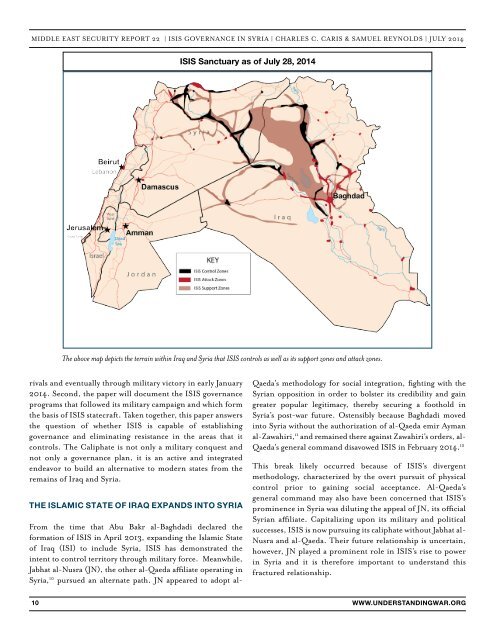ISIS_Governance
ISIS_Governance
ISIS_Governance
Create successful ePaper yourself
Turn your PDF publications into a flip-book with our unique Google optimized e-Paper software.
Middle East Security Report 22 | <strong>ISIS</strong> <strong>Governance</strong> in syria | Charles C. Caris & Samuel Reynolds | july 2014<br />
<strong>ISIS</strong> Sanctuary as of July 28, 2014<br />
The above map depicts the terrain within Iraq and Syria that <strong>ISIS</strong> controls as well as its support zones and attack zones.<br />
rivals and eventually through military victory in early January<br />
2014. Second, the paper will document the <strong>ISIS</strong> governance<br />
programs that followed its military campaign and which form<br />
the basis of <strong>ISIS</strong> statecraft. Taken together, this paper answers<br />
the question of whether <strong>ISIS</strong> is capable of establishing<br />
governance and eliminating resistance in the areas that it<br />
controls. The Caliphate is not only a military conquest and<br />
not only a governance plan, it is an active and integrated<br />
endeavor to build an alternative to modern states from the<br />
remains of Iraq and Syria.<br />
The Islamic State of Iraq Expands into Syria<br />
From the time that Abu Bakr al-Baghdadi declared the<br />
formation of <strong>ISIS</strong> in April 2013, expanding the Islamic State<br />
of Iraq (ISI) to include Syria, <strong>ISIS</strong> has demonstrated the<br />
intent to control territory through military force. Meanwhile,<br />
Jabhat al-Nusra (JN), the other al-Qaeda affiliate operating in<br />
Syria, 10 pursued an alternate path. JN appeared to adopt al-<br />
Qaeda’s methodology for social integration, fighting with the<br />
Syrian opposition in order to bolster its credibility and gain<br />
greater popular legitimacy, thereby securing a foothold in<br />
Syria’s post-war future. Ostensibly because Baghdadi moved<br />
into Syria without the authorization of al-Qaeda emir Ayman<br />
al-Zawahiri, 11 and remained there against Zawahiri’s orders, al-<br />
Qaeda’s general command disavowed <strong>ISIS</strong> in February 2014. 12<br />
This break likely occurred because of <strong>ISIS</strong>’s divergent<br />
methodology, characterized by the overt pursuit of physical<br />
control prior to gaining social acceptance. Al-Qaeda’s<br />
general command may also have been concerned that <strong>ISIS</strong>’s<br />
prominence in Syria was diluting the appeal of JN, its official<br />
Syrian affiliate. Capitalizing upon its military and political<br />
successes, <strong>ISIS</strong> is now pursuing its caliphate without Jabhat al-<br />
Nusra and al-Qaeda. Their future relationship is uncertain,<br />
however, JN played a prominent role in <strong>ISIS</strong>’s rise to power<br />
in Syria and it is therefore important to understand this<br />
fractured relationship.<br />
10 www.Understandingwar.org


